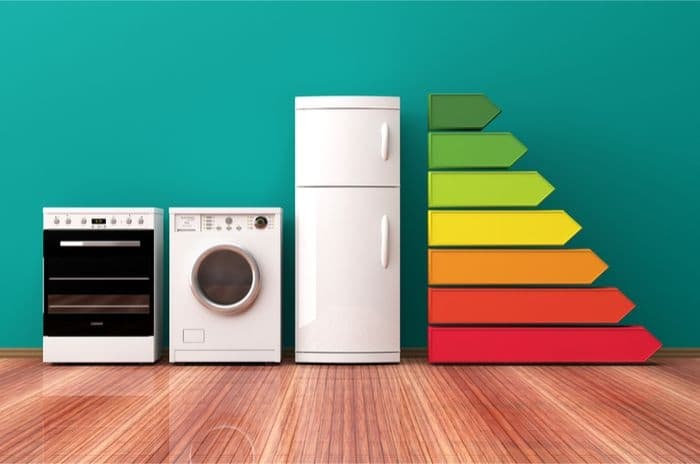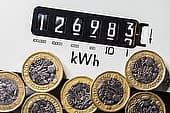Electric showers are one of the costliest products in our home, with immersion heaters also expensive to run.
Smart devices and modern tech draw comparatively little energy, so charging these items shouldn't impact our bills too much.
The key to understanding how much an appliance or device will cost to run is by checking the kW rating alongside the unit cost for your electricity.

Which home appliances consume the most energy?
Energy efficient appliances and products can make a significant difference to our home energy bills, so it's worth thinking about which appliances consume the most energy and which cost the most to run.
When we're buying new appliances, it's important to check the energy label to understand how energy efficient a product is. There's more information on this below, but there are a few things to remember when choosing an appliance:
- The larger the appliance, the more energy it consumes. So, two appliances that have the same energy efficiency rating may not cost the same to use because one is bigger than the other.
- Choose an appliance based on the energy rating and size, as well as budget - the cheapest products are rarely the most energy efficient and will cost more over time.
Some small appliances that we use for short periods can be the most power hungry.
For example, many kettles are 3000W (3kW), yet we only use them for short bursts and not for hours at a time. Conversely, a broadband router that's on all the time may only use 10W - much less, even if it's on all day.
Let's look at some of the most energy intensive appliances in our homes using a kWh cost of 28p. We explain more about these energy calculations later in this guide.
1. Electric showers
Electric showers are one of the most expensive things to run in a home, often rated between 7kW and 10.5kW.
So, if we were to run an electric shower using those averages, it would cost:
- Between 65p and 93p if the shower ran for 20 minutes
- Between £1.96 and £2.80 if the shower ran for an hour
While we're unlikely to take showers that last for an hour, it's perfectly feasible that a small family could use the shower for an hour every day or every other day.
If the shower was used for an hour every other day, that would cost between £29.40 and £42 just to run the electric shower in a typical month.
2. Electric immersion heaters
Immersion heaters are less common than they used to be, partly because they cost so much to run.
These water heaters have an element inside that heats the water around it. Theoretically, these tanks should be well insulated but, however, good the insulation is, they keep losing heat and have to continue coming back to the right temperature.
The wattage of an immersion heater is usually around 3kWh:
- It would cost around 84p to run the immersion heater for an hour
- It would cost around £4.20 to run the immersion heater for five hours
Immersion heaters should never be left on when they're not being used, meaning households that rely on them for hot water need to think carefully about when they need to be switched on.
If we use an immersion heater for an hour per day, it would cost around £25 per month. Three hours a day would cost around £75, making an immersion heater one of the most expensive things you can leave accidentally running in your home.
Some households with immersion heaters could benefit from an Economy 7 tariff that provides cheaper rates of energy overnight.
3. Tumble dryer
Tumble dryers are contentious, with many people pointing out that line drying or inside drying on a wire rack is a much cheaper. However, those options aren't available for all, leaving a tumble dryer as the default option.
Many tumble dryers are between 2kW and 3kW, so it would cost:
- Between 56p and 84p to run a tumble dryer for an hour
- Between £1.12 and £1.68 to run a tumble dryer for two hours
If we used the dryer for five hours per week, it would cost between £11.20 and £16.80 in a typical month.
Some tumble dryers come with sensors that stop automatically when clothes are dry. These are better options and are more energy efficient, although they are likely to be more expensive.
4. Washing machine
Choosing an energy efficient washing machine can have a doubly positive impact if we have a water meter, saving us money on both our energy and water bills.
Washing machines can vary dramatically in how energy efficient they are, with appliances usually ranging between 1.2kW and 3kW.
Some also have eco settings that will improve their efficiency, but it will depend on the cycles that customers choose to use.
If we use that broad range of wattages, we can estimate that a washing machine would use:
- Between 34p and £1 for one hour of running the machine
- Between £1 and £3 for three hours of running the machine
Over the course of a month, if we used the washing machine for eight hours a week, it could cost between £32 and £96.
As we mentioned above, some washing machines have eco-friendly settings to improve their energy efficiency. This could help to bring costs down, as could washing at a lower temperature wherever possible.
5. Dishwasher
A dishwasher is usually rated between 1kW and 1.5kW.
As with washing machines, the cycles can vary too, meaning the average energy consumption of the appliance is difficult to pinpoint without focusing on a specific model.
However, using the above ranges, it would cost:
- Between 28p and 42p to operate a dishwasher for an hour
Many households will use their dishwasher once a day, so it would cost between £8.40 and £12.60 over the course of a month.
Again, plenty of people will argue that a dishwasher is costlier than washing in a bowl with hot water, yet it might depend on whether a household has an immersion heater (see above).
Dishwashers can be water guzzlers, although many are more efficient on that score than they used to be. It's still something to bear in mind for those on water meters, however.
6. Fridge freezers
Whether we have a standalone fridges and freezers or a fridge freezer, these are appliances that are on constantly and therefore it definitely pays to get an energy efficient one.
As we discussed earlier, the amount of energy an appliance consumes will often depend on its size, so it makes sense to choose a smaller fridge freezer rather than a huge one that will guzzle energy.
Equally, while these appliances may be on constantly, it doesn't necessarily follow that they're drawing energy the entire time.
They cycle on and off to keep items inside cool, so it's difficult to estimate how much energy an individual model will use per hour and, consequently, per day or per month.
So, when buying a fridge, freezer or fridge freezer, be sure to check the kWh rating on the energy label to understand how much it will truly use per hour.
Other products
The key to understanding how much energy an appliance or device uses is to find out its wattage.
As a guide, here are some common products that we haven't covered above with their approximate power rating and the cost of using them for an hour (still based on the rate of 28p per kWh.
| Average power rating (in kW) | Cost to use for an hour | |
|---|---|---|
| Kettle | 3kW | 84p |
| Electric fire | 2kW - 3kW | 56p - 84p |
| Oven | 2kW - 2.2kW | 56p - 62p |
| Hairdryer | 2kW | 56p |
| Oil-filled radiator | 1.5kW - 2.5kW | 42p - 70p |
| Iron | 1kW - 1.8kW | 28p - 50p |
| Toaster | 0.8kW - 1.5kW | 22p - 70p |
| Microwave | 0.6kW - 1.5kW | 17p - 70p |
| Vacuum cleaner | 0.5kW - 1.2kW | 14p - 70p |
Many of these appliances are things we use for a few minutes at a time rather than a whole hour.
That said, the cumulative use over a week or month can add up. If we used the kettle for an hour a day, it would cost around £25 over the course of a month.
The good news for our smart tech and entertainment devices is that these generally draw very little energy. Here are some examples:
| Average power rating (in kW) | Cost to use for an hour | |
|---|---|---|
| LCD TV | 0.125 - 0.2 | 84p |
| Desktop computer | 0.08 - 0.2 | Around 1p |
| Laptop | 0.02 - 0.07 | Around 1p |
| Tablet (charging) | 0.01 | Less than 1p |
| Broadband router | 0.01 | Less than 1p |
| Smartphone (charging) | 0.01 | Less than 1p |
At this level, the differences are small and leaving our broadband router on all day will not cost much compared to the hassle of turning it on and off.
In fact, because such products often use more energy when they're powering up, it can be counterproductive to turn them on and off regularly.
Understanding energy efficiency labels
Every home appliance and electrical product comes with an energy label to explain how energy efficient it is and to allow for simple comparisons between similar products.
These labels have been used for over 25 years but they underwent a revamp in 2021 to ensure that A rated appliances were the most efficient in their ranges.
Before this, it was common to see A, A+, A++ and even A+++ ratings to denote higher levels of energy efficiency. This was justifiably criticised as too confusing for customers, so a new A to G system was brought into force.
This is how it works:
- Every product is given an energy efficiency rating between A and G
- A is the most energy efficient but this is given to very few products
- Most products that are deemed to be 'best in class' will be rated C or lower because there is room for improvement
What this means is that an appliance purchased a couple of years ago with an A++ rating might end up as a C under the new system - it doesn't mean the energy efficiency of the product has decreased but just that the scale for measuring it is now more stringent.
Depending on the product group, energy efficiency labels may also contain other information such as:
- Energy consumption in different modes
- Annual energy consumption
- Water consumption
- Capacity of compartments
- Duration of Eco modes
- Airborne acoustical noise emissions
So, these labels have much more useful information than they did before, meaning customers can look at two products side by side to understand which appliance will cost less to run.
For more information about the new energy label and what the specific labels for products like dishwashers and TVs look like, visit the Label 2020 website.
How to calculate appliance running costs
All energy is measured in watts (W). When the number of watts exceeds 1,000, it is measured is kilowatts (kW).
Knowing the wattage of a product is only one part of the puzzle - we then need to know how long the product is being used for to understand how much it will cost to run.
This is done by working out how many hours the appliance is on for and is expressed as kilowatt-hours (kWh).
When we receive our energy bills, the amount of gas and electricity we've used is listed in kWh, so this is the figure that tells us how much energy an appliance or device is using and how much that costs.
Making the calculations
To find out what an appliance is costing to run, the calculation is straightforward.
We need to work out the wattage of the appliance, multiply it by the hours it's being used, divide all this by 1,000 and then multiply the sum by our kWh rate in pounds.
It sounds complicated, but it's not. Here's how it looks when we write it down as a sum:
(wh / 1000) x r
Adding some numbers into the sum may make it easier to understand.
Let's say we want to use a 1,200w washing machine for two hours. Our rate is 28p per kWh. Here's how the sum looks now:
((1200 x 2) / 1000) x 0.28
1,200 multiplied by two is 2,400, divided by 1,000 is 2.4.
Using a calculator for the next bit, 2.4 multiplied by 0.28 comes out as 0.672. The answer is given in pounds, so we now know that our washing machine will cost 67.2p to use for two hours.
Appliance calculators can be found online to help us work out these details, but the important thing is to check the wattage of our appliances and other devices to give us a clearer idea of how much they cost per hour of use.
Summary: Check the labels
Thanks to the new energy efficiency labels, it's easier than ever to understand exactly how much energy appliances and devices around the home are consuming.
Although the calculations to work out how much that actually costs in pounds and pence look complicated, they follow a simple formula that should help you to figure out the true cost of an appliance - as long as you have the kW of the product and know your unit rate.
There are devices that can help bypass this step in the form of energy monitors, and we've rounded up some of the best energy monitors to help you reduce your energy bills in a separate guide.
Choosing the most energy efficient appliances when we're shopping for new products may stretch our budgets, but it's important to consider the savings we might make over the long term.
Improving the energy efficiency of a home can also help with some of the costlier things we've covered such as oil radiators and electric fires, since keeping more heat inside means those appliances don't have to work as hard.









Comments (2)